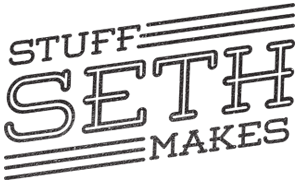Are you working on restoring an old sewing machine? Recently I was asked to work on a vintage Singer sewing machine cabinet. The sewing machine itself was out of commission and the owner wanted the remaining cabinet to be used as a desk for his granddaughter. I think his idea was that I’d just put a new top on it and be done. But come on…this is Stuff Seth Makes…I had to go a couple steps further than that!
If you want to be cool, check out the full build video:
When I picked up this project and put it in the bed of my truck, the gears in my head were already turning with ideas of how I wanted to tackle it. When I got it back to the shop I could finally take a look at the condition this was in. The original top was pretty beat up and definitely needed to be replaced. The drawers themselves were okay and could be kept, but I saw some issues with the frames around the drawers.
.jpg)
.jpg)
The cast iron base was in decent shape, but it had a lot of dirt and grime on it that would need to be deep cleaned. The word “SINGER” in the middle of the cast iron was totally fine….but that was about to become one of the coolest modifications on this project. More about that in a minute.
.jpg)
I used some oak I had leftover from the church cross project I did last year. This oak was salvaged from the pews that were being replaced at my church. So right off the bat, this sewing machine cabinet makeover is going to have some history built into it.
As I built new parts for this sewing machine cabinet, I used modern woodworking tools that you might find in most small shops. I’ll have links at the end of this post to some of my favorite tools I used on this project. Even though I tried to measure properly I still managed to make a boo-boo when making the “tracks” on one of the drawer frame pieces. Somehow I messed up which would have caused the “tracks” to be too close:
.jpg)
I thought of several different ways to correct my error. I could do something at the table saw, or something at the router table, or even something using the handheld router free hand or with a jig/template. As I thought about these options however, I started thinking about different scenarios that could ruin my piece, or even worse….ruin my fingers or hands. Sooooo, I thought of a way I could use my Shapeoko CNC machine to remove the necessary material safely. Make sure you check out my full build video to see this in more detail, as well as the rest of the assembly of these parts.
.jpg)
In addition to building a new desktop, I also put breadboard ends on it. Breadboard ends are a woodworking technique used to help keep tabletops flat, and to keep the boards from warping. This was the first time I’ve attempted breadboard ends and I built a special jig for my tablesaw fence to help me do this. It turned out great and helps to preserve the antique look and feel of this Singer cabinet. All of the wood parts got sanded and stained with my own blend of a couple different General Finishes water based stains. Then I finished with a couple coats of General Finishes Arm-R-Seal.
.jpg)
One of the coolest modifications on this project has to do with the SINGER word in the middle of the cast iron. I had the idea of cutting out the word SINGER and replacing it with the client’s last name, SLONSKI but I wanted to make sure it looked like it still fit the style of the cast iron and looked appropriate. I cut out the original letters using my Dremel tool with a cutoff wheel and cleaned up the area with a couple different carbide burrs. I’ll have a link to those bits further down this blog entry. Once I had the old letters out, I took some measurements and started drawing up a design in Carbide Create. Once I found a font I liked and modified it to look even more appropriate, created a g-code file and proceeded to use my Shapeoko CNC machine to cut out some new letters from a piece of birch.
.jpg)
.jpg)
I cleaned up the letters with a mini flush trim bit at the router table and then did some fine-tune sanding until the new letters fit nicely into the original Singer opening. I used the steel reinforced JB Weld epoxy to adhere the letters. Putting the last name into the cast iron was a total surprise to the owner and after I put a few coats of new black paint on everything, the new letters look just like they were part of the original cast iron! I think it’s my favorite part of this makeover for sure!
.jpg)
One other custom request for this project was to add a small safe to the underside of the desktop. The owner provided a little Fort Knox safe and I made a custom rear wall to mount it on. I used several threaded inserts on different parts of this project, including this safe area.
.jpg)
One last detail before the final assembly was to engrave his granddaughter’s name in a corner of the desktop. It was back to Carbide Create and the Shapeoko CNC for this part. This should have been a pretty easy task…and it was…but once again, I ran into a little problem. Since I had already mounted the small rear panel that the safe would attach to, I wasn’t able to put the desktop on the cnc bed the way I had originally intended to. But thankfully, my mind is ALWAYS running (is that a good thing or a bad thing??) and I was able to come up with another way to line up the desktop in the cnc to get the job done. Again, you can see this in more detail if you watch the full build video.
While I didn’t go over every single detail in the paragraphs above, here’s a list of all the things I did to bring new life to this dumpster-destined Singer sewing machine cabinet:
- Built a new oak top with breadboard ends.
- Built new drawer frames and incorporated brass detail.
- Added a rear wall to mount a small safe to.
- Stained the wood and applied finish.
- Cut out the old cast iron wheels that were broken and stuck, and made new wheels out of the same oak.
- Cut out the original SINGER letters from the cast iron and replaced with last name SLONSKI letters that I machined on my CNC.
- Replaced the old wooden drawer knobs with metal satin black knobs.
- Rethreaded the cast iron bolts and bolt holes.
- New paint on all the cast iron.
- Engraved name on the desktop using my CNC machine.
- Shot and edited a full length video of the whole project.
.jpg)
This whole thing was a lot of work both on the building side of it, and also on the video side of it, but I’m so happy with how everything turned out on this project. At first I thought maybe I bit off more than I could chew but that changed once I got going on it. I was able to try some new things which is always great, and even though I made a couple mistakes along the way, I was still able to troubleshoot, problem solve, and fix those mistakes.
If any of you out there are working on a vintage Singer sewing machine cabinet, maybe my project will help you in one way or another. Make sure you check out the video too. If you’re a visual person like I am, I think you’ll find the video to be a valuable resource when rebuilding or refinishing a Singer sewing machine cabinet. Heck, maybe you’re not even working on the same kind of project but you just like seeing a DIY furniture flip project or a trash to treasure project. The video link is at the top of this blog post, and the video has chapter points so you can easily jump to different parts of the project. I hope it inspires you!
I used a variety of tools on this project, and I’ll put Amazon links below. As an Amazon Associate I earn from qualifying purchases. I appreciate you using my links and any revenue I earn helps me to keep creating content to being to you! Now…here’s those links:
Festool DF500: https://amzn.to/3Lq3FCb
Bessey Parallel Clamps: https://amzn.to/3ILCr7x
Bessey Pipe Clamps: https://amzn.to/36TDSTY
Dado Blade Set: https://amzn.to/3JQ2Our
JET drill press: https://amzn.to/3utqwWE
Spring Clamps: https://amzn.to/3JP5KaE
General Finishes Water Based Stain: https://amzn.to/3tKwwLx
General Finishes Arm-R-Seal: https://amzn.to/3qH8Upa
Makita Track Saw: https://amzn.to/3DqEhtp
Dremel Tool: https://amzn.to/35hNHuC
Carbide Burr Set: https://amzn.to/3iLeW3M
Threaded Inserts: https://amzn.to/3IHo7wF
Threaded Insert Tool: https://amzn.to/3DlLqel
Amana Mini Flush Trim Bit: https://amzn.to/3qHYBkM
JB Weld Epoxy: https://amzn.to/3iLb1ny
Tap & Die Set: https://amzn.to/3Nu0KKM
Fort Knox Safe: https://amzn.to/3iKqtAw
Right Angle Drill Attachment: https://amzn.to/3Nw36ZG
Canon M50 Camera Kit: https://amzn.to/3NtrH0X
Thank you , thank you, thank you for stopping by and checking out this project!! Be sure to find me on the following social media platforms:
Instagram: http://www.instagram.com/stuffsethmakes
YouTube: http://www.youtube.com/stuffsethmakes
Facebook: http://www.facebook.com/stuffsethmakes
YOU GUYS ARE THE BEST!! See you on the next one!!







